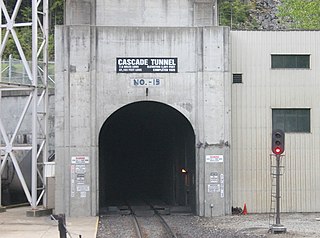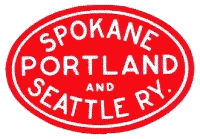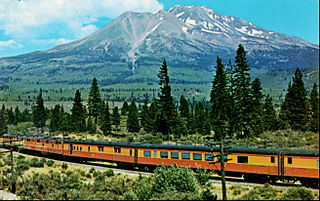
The Great Northern Railway was an American Class I railroad. Running from Saint Paul, Minnesota, to Seattle, Washington, it was the creation of 19th-century railroad entrepreneur James J. Hill and was developed from the Saint Paul & Pacific Railroad. The Great Northern's route was the northernmost transcontinental railroad route in the U.S.

The Empire Builder is a daily long-distance passenger train operated by Amtrak between Chicago and either Seattle or Portland via two sections west of Spokane. Introduced in 1929, it was the flagship passenger train of the Great Northern Railway and was retained by Amtrak when it took over intercity rail service in 1971.

The Cascade Tunnel refers to two railroad tunnels, its original tunnel and its replacement, in the northwest United States, east of the Seattle metropolitan area in the Cascade Range of Washington, at Stevens Pass. It is approximately 65 miles (105 km) east of Everett, with both portals adjacent to U.S. Route 2. Both single-track tunnels were constructed by the Great Northern Railway.

The Spokane, Portland & Seattle Railway was a railroad in the northwest United States. Incorporated in 1905, it was a joint venture by the Great Northern Railway and the Northern Pacific Railway to build a railroad along the north bank of the Columbia River. The railroad later built or acquired other routes in Oregon. The SP&S was merged into the Burlington Northern in March, 1970. Remnants of the line are currently operated by BNSF Railway and the Portland and Western Railroad.

The North Coast Limited was a named passenger train operated by the Northern Pacific Railway between Chicago and Seattle via Bismarck, North Dakota. It started on April 29, 1900, and continued as a Burlington Northern Railroad train after the merger on March 2, 1970 with Great Northern Railway and the Chicago, Burlington and Quincy Railroad. The next year, it ceased operations after the trains which left their originating stations on April 30, 1971, the day before Amtrak began service, arrived at their destinations.

The North Coast Hiawatha was a streamlined long-distance passenger train operated by Amtrak between Chicago, Illinois, and Seattle, Washington.

The Olympian and its successor the Olympian Hiawatha were passenger trains operated by the Chicago, Milwaukee, St. Paul and Pacific Railroad between Chicago and the Pacific Northwest. The Olympian operated from 1911 to 1947 and was, along with its running mate the Columbian, the first all-steel train to operate in the Pacific Northwest. The streamlined Olympian Hiawatha operated from 1947 to 1961 and was one of several Milwaukee Road trains to carry the name "Hiawatha". The Olympian Hiawatha was designed by industrial designer Brooks Stevens and included the distinctive glassed-in "Skytop" observation-sleeping cars. It later featured full-length "Super Dome" cars.

The Spokane Intermodal Center is an intermodal transport facility located in Spokane, Washington, United States. It serves as a service stop for the Amtrak Empire Builder, as well as the Greyhound, Trailways, and Jefferson Lines station for Spokane. The Empire Builder provides service daily between Chicago, Illinois and Spokane before continuing on to Seattle, Washington or Portland, Oregon.

Columbia Station, also known as Wenatchee station, is an intermodal train and bus station in Wenatchee, Washington, United States. It is a stop on Amtrak's Empire Builder train and is the main hub for Link Transit, the local bus system serving Wenatchee and surrounding areas. The station is also served by intercity buses operated by Grant Transit Authority, Northwestern Trailways, and Travel Washington.

The Northern Transcon, a route operated by the BNSF Railway, traverses the most northerly route of any railroad in the western United States. This route was originally part of the Chicago, Burlington and Quincy Railroad, Northern Pacific Railway, Great Northern Railway and Spokane, Portland and Seattle Railway systems, merged into the Burlington Northern Railroad system in 1970.

The Western Star was a named passenger train operated by the Great Northern Railway between Chicago and the Pacific Northwest via Minneapolis/St. Paul, Minnesota. Between Chicago and St. Paul the train used the route of the Chicago, Burlington and Quincy Railroad; in later years eastbound passengers were accommodated on Burlington trains east of St. Paul. Through cars from the train operated between Spokane, Washington and Portland, Oregon via the Spokane, Portland and Seattle Railway. It operated from 1951 to 1971.
The Gopher and Badger were trains operated by the Great Northern Railway and then Burlington Northern Railroad until the start of Amtrak between Saint Paul, Minnesota and the Twin Ports of Superior, Wisconsin and Duluth, Minnesota via Cambridge and Sandstone.

The Shasta Daylight was a Southern Pacific Railroad passenger train between Oakland Pier in Oakland, California, and Portland, Oregon. It started on July 10, 1949, and was SP's third "Daylight" streamliner; it had a fast 15-hour-30-minute schedule in either direction for the 713-mile (1,147 km) trip through some of the most beautiful mountain scenery of any train in North America. The Shasta Daylight replaced heavyweight trains on the same route that had taken nearly a day and night to complete the run. The Shasta Daylight was the first diesel powered Daylight and the only Daylight to run beyond California. The scenic route of the Shasta Daylight passed its namesake Mount Shasta in daylight hours.

The Los Angeles Limited was a named passenger train in the United States. It was operated by the Union Pacific Railroad from 1905 to 1954.
The Scenic Subdivision or Scenic Sub is a railroad line running about 155 miles (249 km) from Seattle, Washington to Wenatchee, Washington. It is operated by BNSF Railway as part of their Northern Transcon. This route includes the Cascade Tunnel, as well as the 1893 site of the "last spike" near Scenic, Washington, which marked the completion for the Great Northern Railway transcontinental railway line built by James J. Hill.

Icicle Station, also known as Leavenworth station, is a train station in Leavenworth, Washington, United States. It is served by two daily Amtrak trains on the Empire Builder, which travels west to Seattle and east to Chicago. The station has one platform and is located northeast of downtown Leavenworth, which is noted for its Bavarian village theme.

The Great Northern Z-1 was a class of ten electric locomotives built for the Great Northern Railway They were used to work the route through the second Cascade Tunnel. They were built between 1926–1928 by Baldwin Locomotive Works, with Westinghouse electrics, and stayed in service until dieselisation in 1956. Each was of 1,830 horsepower (1,360 kW) with a 1-D-1 wheel arrangement, although they were always used in coupled pairs.

The Glacier Park Limited was a named passenger train operated by the Great Northern Railway in the United States that ran between St. Paul and Seattle between 1915 and 1929. The Glacier Park Limited came to be when another one of Great Northern's St. Paul to Seattle routes, The Oregonian was renamed. The Limited also had a split with a small consist going to Portland along the route of the Spokane, Portland and Seattle Railway. The train was meant to promote Great Northern's on-line scenic attraction Glacier Park as a tourist destination, advertising the park's unequaled scenery and easy access by its trains, which stopped on both the Eastern and Western edge of the park.

The Great Northern S-2 was a class of 14 4-8-4 "Northern" type steam locomotives built by the Baldwin Locomotive Works in 1930 and operated by the Great Northern Railway until the late 1950s.

Great Northern 2507 is a 4-8-2 "Mountain" type steam locomotive, a member of the P-2 class. Built for passenger service, the locomotive was assigned to pull the Great Northern's mainline passenger trains such as the Empire Builder and Oriental Limited, until being retired in December 1957 and sold to Spokane, Portland and Seattle Railway. GN 2507 is one of only two surviving examples of a P-2 class locomotive and, since 2003, has been on display at Wishram station in Wishram, Washington.


















